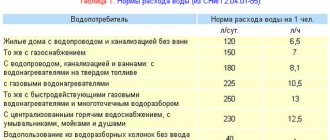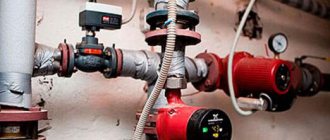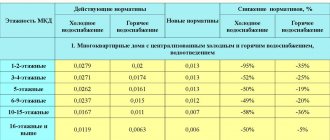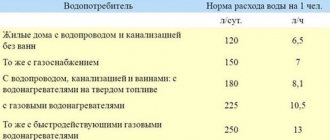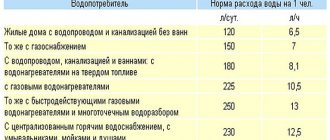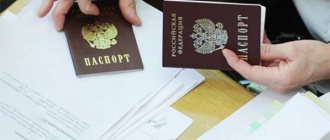Average expenditure per person per month according to standards
By law, the average water consumption per person per month is defined as 6.935 m³ of cold water and 4.745 m³ of hot water, which follows from the standards for payment of utility services in the absence of a water supply meter.
We talked in more detail about the monthly consumption rates without a meter per person in this article.
How did such a significant volume come about?
Calculations of the consumption of cold water, which is spent daily for household and household needs in an apartment or private household, can be imagined to be about 240 l/day:
- hygienic shower – up to 30 l;
- washing, shaving, washing hands - up to 30 l;
- toilet flush – almost 200 l;
- bathing in the bathroom – 40-50 l;
- kitchen needs and home cleaning - up to 40 liters.
Hot water is consumed less for similar needs, excluding flushing the toilet tank, which is expressed in amounts up to 160 l/day.
The amount of water consumption according to the meter can vary between 4-15 liters/month for cold water supply and about 2-8 liters/month per resident, based on:
- habits;
- lifestyle;
- frequent and prolonged absences;
- operating mode.
Prices in regions
The cost of water varies across regions. The norms of the Russian Federation are taken as a basis everywhere; other costs vary depending on:
- climatic features;
- new equipment;
- population density;
- cost of resources spent on heating water;
- living wage, which determines the payment of water supply employees.
Average cost of water supply in the Russian Federation:
- For hot water: range from 85 to 200 rubles.
- For cold water: from 24 to 40 r.
Reasons for high meter consumption
When a significant amount is charged for water consumption per month, the question arises: what are the reasons for such excessive consumption of water resources?
Why does the meter move a lot?
It happens that the meter has been verified and installed, the pipeline is new and there are water filters, but the water meter readings are simply surprising.
If the meter in the apartment increases a lot, you need to consider the following points in more detail:
- Water leakage from the pipeline system in the apartment:
- toilet flush cistern with a leaky flush valve and losses of up to 2-3 m³ of cold water per month;
- valves that are not tightly closed and water is dripping from them.
- Reluctance to rationally use water by all residents of the apartment:
- taking a full bath;
- long showers;
- daily laundry or washing dishes with an incomplete load;
- taps that are not closed when washing or brushing teeth, washing dishes or cleaning the apartment.
Why does it show inflated numbers?
Sometimes the reason for increased water consumption lies not in residents or plumbing fixtures, but in the nuances of the water meter or pipeline supplying hot or cold water:
- Problems with the installation of the water meter and the device itself:
- failure of the sealant in the water meter manifests itself in the form of fogged glass above the meter scale or leaks in the body;
- erroneous installation and installation of a water meter for hot water to cold water supply and vice versa, which leads to inflated tariffs.
- Condition of the water supply network and supplied water:
- high content of foreign impurities in pipeline water - rust or salts, which are deposited on the rotating blades of the meter and change the speed of rotation of the numbers on the dial;
- high water pressure in high-rise buildings leads to water losses if consumption is neglected - up to 20 liters per minute (find out what to do with low pressure and about pressure standards in pipes);
- the forced need to drain hot water of inappropriate temperature, paying for warm water according to the hot tariff schedule.
How many liters of water per day does a family of three need? Interview with a resident of an eco-village
Water is taken from the tap - for the average resident of a comfortable apartment this is akin to an axiom. It's just there - always, by default. Brushing your teeth, showering, washing, washing dishes, you never know what else - can you imagine, each of us, living in the city, spends about 200 liters of water per day on all this... What part of this volume flows into the sewer just like that? which one do we really need?.. I know people who four years ago exchanged the comfortable bustle for a secluded life in the village of Lyubimovo (Perm Territory), which is not even on the map. While their house is under construction, Lyosha and Lena Lesnykh live in a small hut-sauna - without a warm toilet, running water or TV. They run a household and raise a son. For them, water is not just a technical liquid. I thank Lena for agreeing to this interview - it shook me up thoroughly.
You are a former city resident. How quickly did you get used to the lack of amenities like running water?
Even when my husband and I lived in the city, every summer we went with a tent into the forest or on a trip - for a weekend or a month. Therefore, I somehow got used to the fact that water can be in a stream or river. And when we moved to the village for good, the joy of clean spring water overwhelmed all the inconveniences))
How far do you have to walk for water, and how often? How is this technically organized - do you walk with buckets on a rocker?..
There is a ravine near our clearing, and a Spring runs through it. It turns out that the water is 30-50 meters away. My husband often goes to fetch water. In winter we carry it on a rocker, and when the temperature outside is above zero, we use a gas pump to pump water directly into the house, into a special 100-liter tank attached to the stove. Enough for a week. In winter, one walk a day with a rocker is enough for a day, and there is still some left. If you go every morning, there is always plenty of water in the tank. We carry water for drinking in an enamel bucket with a lid and store it in it. One such bucket is enough for a day or two - there is always clean and fresh water. In general, the rocker is a different story. The first time I went to fetch water, I put the yoke on my shoulders, I walked, I was happy - just like the heroine of the picture... Only I couldn’t portray the light gait, the majestic posture... It felt like I didn’t have shoulders, but a wooden hanger - like a model at a fashion show, sharp and bony))) Either women used to have more sloping shoulders, or I’m too stooped, or the yoke was not bent for women’s shoulders. Now I wear it on one shoulder - it doesn’t put so much pressure. In general, the rocker is a convenient thing; a good amount of water can be easily transferred.
Approximately how much water is consumed per day - for what needs?
It turns out that for household needs we need two buckets - that’s 20 liters; plus a 10 liter bucket - for drinking and cooking; plus, if you need to wash something large (pants, shirt), then another bucket in reserve, and if you need to wash something small (socks, T-shirt, etc.), two days’ worth is enough. Water is mainly spent on food for us and the animals (we have 3 goats, 18 chickens, 3 cats and a dog), washing dishes, hands, and for our son’s evening bathing and splashing. On average this is 30-40 liters per day.
You have a growing baby - how much does this increase water consumption? And is it difficult to organize a child’s life in a house without running water and a warm toilet?
When my son was six months old, we had to make another trip with a rocker - add 20 liters. I had to give him a bath. To be honest, he somehow didn’t really like such bathing with us. But when I started sitting, everything changed: now I put him in a basin, pour 5-7 liters of water into a bucket and water it with a mug. He likes it - he also helps me. I like it too)) In general, he likes to pour water. Fortunately, we live in a bath house, so you can splash around in the sink as much as you want. In the summer, when we pumped, it was easier, but now we have to control the water flow. But in any case, more than 10 liters are not wasted. Regarding hot water: if there is a tank near the stove for heating, then everything is convenient. If not, then heating water on the bottom in a kettle to dilute the cold water is also very quick and simple. But the lack of a warm toilet is rather a difficulty for the mother, especially when the child is very small. Mom needs to go to the toilet, and the child needs his mother. But you can’t take it with you and sometimes you won’t leave it. But the problem can also be solved: for example, you can install a dry toilet - there is no smell, and it is not connected to the sewer system. As a last resort, you can put up a simple bucket-toilet for the winter, fill it with snow - and also no unnecessary odors.
How did your attitude towards water change after moving to Lyubimovo?
I began to understand the value of water and the importance of its purity. Now it’s hard for me to watch when someone’s water just runs out in the city. It’s somehow sad that it, so cleansed and warmed, is flowing away into nowhere. People tried hard, cleaned it, heated it, put it through pipes, but we treat it so negligently. Yes, it will flow back into nature, but how much work will it cost a large number of people to return it to our pipes again... I also began to feel where the water in the city is suitable for life and where it is not. Smell, color, taste. When the water is clean, it is tasty and alive. The whole body rejoices in such water. And in the city, in some places, sometimes even washing your hands is unpleasant: the skin dries out and “pimples” appear after the cold. By the way, when I changed my place of residence and water, my “chicks” went away and appear only when I return there.
What manipulations with water are the easiest to save it on? What does the average city dweller usually not do, but for a village resident these actions are taken for granted?
The easiest way to save money is on laundry. You can conduct an experiment: wash socks or underwear under running water and place a container to see how much water runs out during washing. You'll get a whole bucket, or even more! And if you wash in a basin, you can limit yourself to a couple of ladles (this is about 5 liters).
You can also really save on washing your hair. While still living in the city, I somehow managed to wash my long hair (almost to my waist) with a five-liter bottle of water. Some of it was boiled and diluted. The method is the same - over the basin. And the secret is that you can wet your hair with one or two ladles, without pouring this water out, but collecting it in a separate container. And then rinse off the main part of the shampoo with the same water. Conditioning balms, of course, take longer to wash off. It’s better to wash your hair with natural products: mustard, rye flour or yolk. There is less water, but more benefits.
Lever mixers also help save water. It is convenient to turn it off by hand when washing your hands, brushing your teeth and at many other times. You can even make a washbasin without a tap - they usually exist in villages. You can install it as an additional one and pour good water into it, suitable for washing your hands, left after something.
The dishwasher also saves water and allows the use of natural detergents. Some even use it in villages.
Stop wasting water and don’t forget to turn it off. Soak dishes: you can put them in the sink and wash your hands or other dishes over it, then they will partially soak.
Stop using liquid soap. Not only does it wash off poorly and takes a long time, but lauryl sulfate also pollutes the environment.
Dispel some urban myths regarding the use of water (like you need to wash every day, otherwise you will walk around dirtier))).
Every day you need to wash someone who is showered with gray dust and soot every day :) In general, the city is dirty both physically and mentally. Therefore, it is not surprising that city residents wash themselves so often. And if everything is not so bad, then you can go to the bathhouse once or twice a week. Jokes aside, but in the village everything is different. When all the city's dirt is washed away, a feeling of cleanliness sets in, and needs change. Even the bathhouse becomes just a bathhouse, and you no longer want to go to it every day. If you wash with natural products, your hair stays clean twice as long. I have the feeling that after shampoo the dirt sticks on its own. That’s why I want to wash my hair almost every day. I used to have very oily hair, but after switching to mustard it became normal. You just need to experimentally choose your own recipe, and the effect will be better than any shampoo. It seems to me that it’s the same with the body. Bad water>dry skin>cream>dirt sticks to the cream>water again>cream again...etc. So they wash themselves every day and can’t wash themselves off (laughs).
Well, wish something environmentally friendly to those who will read this interview!
I wish everyone to love water, because it is part of us. This beautiful and mysterious substance is one of the foundations of our life. Drink two to three liters of water a day, swim in ponds in the summer, douse yourself if your soul asks (there are those who douse themselves in the city in the yard). If you have a car, go to the springs with tanks, take with you those who do not have a car. It’s better to let it sit for a week in a plastic tank (with a loosely closed lid), on which kind words are written, than for it to run through rusty pipes into your kettle. The one that is sold is not much better than tap water. Plastic bins are convenient for transportation, and you can store them in something more environmentally friendly. Say kind words to the water - it perceives everything and changes its structure. Think when you buy plastic and other garbage. After all, what you throw away ends up in the water! Avoid chemicals and buy organic. Yes, maybe some of them are more expensive, but the planet will be cleaner. Keep in mind that from septic tanks (they are used in private homes as sewers), which are buried deep in the ground, gray water from the house goes directly into groundwater and springs. Of course, it is somehow purified there, but... it is better to study this issue in more detail and choose those systems that do not drain the water deep into the ground. For example, a reed bed to purify gray water (the Internet can help you!). If you already have any household chemicals, then it’s better to just pour it on the ground - it will filter better than any artificial systems.
Live in joy, listen to your heart, love nature, drink more clean water!
PS: The word “Spring” is written with a capital letter deliberately.
How to check the readings?
In a situation where there are doubts about the water meter readings for the past month, you need to check whether the water meter is really working (what to do if the meter is broken?).
The master or controller of the water supply company is authorized to record the suspected malfunction of the device.
Before calling a technician, you should check the operation of the water meter yourself.:
- write down the meter readings in liters – the last 3 digits are red;
- a container of known volume should be filled with water up to the mark indicating its capacity;
- record the readings and repeat the procedure three times;
- the difference in displacement on the meter before and after filling the container should correspond to the collected volume of water.
If the readings and the accumulated volume do not correspond, then you need to submit an application for dismantling, verification, repair or replacement of the meter by the water supply organization . Heat supply companies are responsible for the supply of hot water, and the city water utility service is responsible for the supply of cold water.
How to reduce payments for hot and cold water supply in an apartment?
Rational and justified savings can help not only in conserving water resources, but also financial resources that will be used to pay for unwisely used water supply.
Use the simplest tips:
- wash your hands, wash your face or brush your teeth using a small amount of water;
- check the serviceability of the plumbing and the absence of leaks, especially from the toilet cistern;
- Run your dishwasher and washing machine with a full load.
How to save on water
There are several simple ways to reduce your water bills:
- installation of an individual metering device;
- use of equipment that reduces water consumption;
- installing a shower instead of a bathtub;
- not using purchased water;
- installing a dishwasher – saves up to 1/5 of all water;
- installation of an automatic washing machine;
- using an economical toilet flask.
We recommend: Domestic water meter ECO NOM
If you have a meter installed, you pay only for the water you use without increasing surcharges, and you can also reduce your water consumption, thereby saving money. When a meter is installed, bills will not be accrued during your absence.
Economical consumption will allow you to save water - in particular, do not leave the water tap open unless necessary, and also monitor the serviceability of your equipment.
How to calculate monthly consumption?
The need to calculate how much water was used over the past month arises before submitting this information to controllers.
On the cold water and hot water meters, there are 8 numbers on the dial: on the left, 5 black numbers indicate cubic meters of liquid passed, and 3 red numbers on the right indicate the volume of water consumed. The values of the first 5 black digits indicating the volume of cubic meters used are transmitted to the water supply company. Red numbers are rounded according to the rules of arithmetic to the nearest number.
The formula for calculating cold or hot water used per month looks like this:
V current month = V readings at the end of last month - V readings at the end of the current month
For example: the value V of the reading at the end of last month = 01081432 shows that since the installation of the meter, 1081 m3 432 liters have been used, rounded - 1081 m³.
After a month on the meter, the value on the dial reached V reading at the end of the current month = 01098768, which must be understood as the use of 1098 m3 768 l, rounded - 1099 m³.
Thus, the water consumption for 1 month will be the difference between the water meter readings at the end of the previous and the end of the current month: 1099-1081=18 (m3;).
Number V current month = 18 m3 and must pass through payment documents in the current month.
About the methodology for calculating water supply standards
The issues of establishing standards for the consumption of cold and hot water, taking into account wastewater disposal, are defined in Resolution No. 354, adopted by the Government of the Russian Federation in May 2011.
Document for downloading and reading (Word): Russian Government Decree No. 354.
Tables of standard costs (SNiP 2.04.01-85): Internal cold and hot water supply systems.
The main indicators set out in the document were developed back in the Soviet era, taking into account actual measurements of resource consumption by consumers and processing of the information received.
According to the measurements, it was found that the following amount of water is sufficient for one person per month when used for certain needs (indicated in liters):
- washing in the shower – up to 900;
- cooking - up to 100;
- wash clothes – up to 100;
- wash your face, wash the dishes – up to 180;
- bath - up to 800 when taken once a week;
- toilet and other purposes - up to 550.
Water consumption rates per day
Measurements were carried out in several apartment buildings, after which the resulting value was divided by the number of residents. Based on the consumption of resources, tariffs were determined that were sufficient to recoup the costs.
Cold water supply
Calculation of cold water supply is carried out using the following formula:
Сх = n*Np*Tr*Kp,
Wherein:
- n – number of registered residents in the apartment;
- Np – calculated norm for one tenant;
- Tr – tariff in force in the region, determined taking into account the costs of supplying resources;
- Кп – increasing correction.
The use of an increasing coefficient is due to the fact that the number of actual consumers may be larger, and not all of them pay utility bills in a disciplined manner, and also to encourage residents to install water meters.
As a result of calculations, it was established that about 7 thousand liters of water are sufficient for one consumer over a monthly period. The amount of consumption is determined by the following features:
- climatic;
- seasonal fluctuations in temperature and weather;
- efficiency of devices used at home;
- serviceability of cranes;
- personal habits of residents.
People living in areas with a hot climate use cold water more intensively than in northern regions. This pattern is also characteristic of the seasons.
If home equipment is in poor condition or has uneconomical characteristics, consumption increases significantly.
Hot water supply
Statistical analysis showed that the volume of hot water consumption is half that of cold water. The average monthly consumption is about 3 thousand liters.
Higher tariffs compared to cold water are due to the need to spend additional resources on heating. Other organizations are also involved in filing, so a split payment is required.
Water disposal
Standards for drainage vary by region and range from 14 to 38 cubic meters per month.
The determination of tariffs is within the competence of local authorities and is carried out depending on the technical equipment of wastewater disposal facilities, the condition and degree of wear of the equipment, and other indicators that determine the amount of costs.
Calculator
On the website of the Federal Antimonopoly Service of Russia there is access to a service for calculating the cost of housing and communal services in all regions according to the tariff schedule and standards for hot and cold water consumption provided by municipal tariff regulators. These norms must be drawn up by municipal authorities in accordance with the norms of Federal Law No. 210, which regulates the tariffing of public water supply services.
The calculation service allows you to correlate tariffs for services for the population, carried out according to regional payment documents, with the grid of established federal tariffs and consumption standards for water supply services. This option will allow consumers to locally control tariffs and standards for compliance with all-Russian values adopted under the law on state regulation of tariffs.
Find out more information in the materials on our website about water supply and the problems that arise with it. Read about water quality standards, recalculation and sealing procedures, who is responsible for risers and their replacement, why water can be turned off, as well as what to do and where to go if the device breaks down and other nuances of operating water meters.
Drinking water consumption in different countries and its geographical distribution
According to scientists, over the past century, the rate of water consumption has been several times higher than the rate of population growth on the planet. It is expected that by 2050, about 80% of people will be born in regions with water shortages and poor sanitation. This mainly applies to countries in South Asia and Africa.
The most favorable conditions are found in states that own large, renewable fresh resources. These are Canada, Russia, Brazil and some other countries.
However, there are states with a shortage of natural water (UAE, Kuwait, Saudi Arabia), but consuming more of it than their renewable reserves allow. In figures, consumption in these countries ranges from 250% in Saudi Arabia to 2000% in Kuwait. These are imports purchased through the sale of oil and gas.
Some African countries are in the worst situation, where consumption is no more than 100 cubic meters. per year, per person (including expenditure on agriculture, which requires more water than a person needs).
It is interesting that more water is needed for human domestic needs than for industry and agriculture. For example:
- To produce 1 ton of steel, about 280 tons are consumed; for 1 ton of paper – 700 tons; To grow 1t of wheat, 1.5t is required.
- The most water-consuming industry is electricity production - 44% of all water consumed by industry.
- Developed countries consume from 150 to 400 liters per day per person, with a consumption rate of 105 liters to 175 liters.
Obviously, more than half is wasted without benefit.
